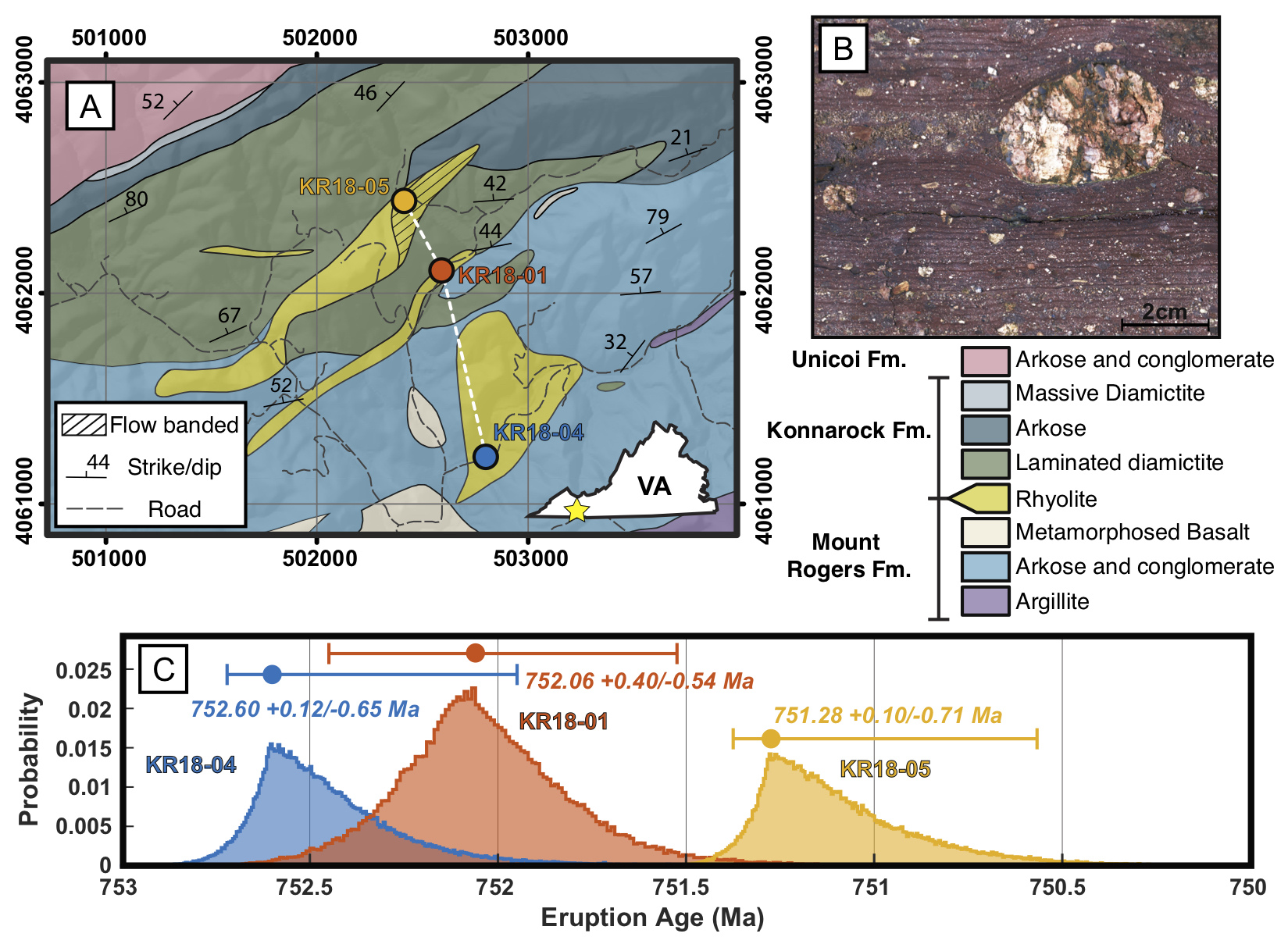The Snowball Earth Hypothesis predicts that there were periods during Earth history where the entire planet was covered in ice. The primary evidence for this comes from paleomagnetic constraints on glacial rocks that indicate glaciers were present at low latitudes at sea level during certain time periods in the Neoproterozoic.
One of the key predictions of the Snowball Earth hypothesis is that glacial deposits from all around the world should have a very similar age, as the onset to glacial conditions should take thousands of years. This is well within the uncertainty of dating techniques, which is around 500000 years in the Neoproterozoic.
 Figure 1: Summary diagram of our work in Ethiopia with other preSturtian sections with age constraints from around the world for context
Figure 1: Summary diagram of our work in Ethiopia with other preSturtian sections with age constraints from around the world for context
The Neoproterozoic sedimentary rocks in northern Ethiopia are a great place to test this prediction out, as they consist of a relatively well preserved sequence of shallow water carbonates and siliciclastics, with occasional interbedded tuffs. So we’re able to get chemostratigraphic data from the carbonates, and U-Pb age constraints from the interbedded tuffs if there is zircon present.
We had some great success in Ethiopia, as we were able to find tuffaceous material stratigraphically very close to the Islay anomaly (a carbon isotope excursion that many used to think was associated with the onset of the first glaciation), as well as stratigraphically near the first unambiguous glacial sediments.
 Figure 2: A felsic tuff from the Tsaliet Group in northern Ethiopia. Note the lapilli at the base of the tuff layer
Figure 2: A felsic tuff from the Tsaliet Group in northern Ethiopia. Note the lapilli at the base of the tuff layer
Building off of this success, my collaborators and I wanted to test whether all Neoproterozoic diamictites fit within the currently well constrained time limits of the Cryogenian.
The problem is that most Neoproterozoic sedimentary basins are from passive margin tectonic settings so the possibility of finding felsic tuffs or extrusive volcanics is very low, that’s what makes the Tambien Group so special!
 Figure 3: Geologic map and geochronology results for the Konnarock Formation. We used a Bayesian methoed to take individual zircon dates to come up with estimates for the eruption age of the rhyolite flows. As you can see the rhyolites get younger going up the stratigraphy so we can safely assume they constrain the age of the diamictites around them
Figure 3: Geologic map and geochronology results for the Konnarock Formation. We used a Bayesian methoed to take individual zircon dates to come up with estimates for the eruption age of the rhyolite flows. As you can see the rhyolites get younger going up the stratigraphy so we can safely assume they constrain the age of the diamictites around them
But there was one very promising candidate- the glacigenic Konnarock Formation in SW Virginia. These glacially influenced laminated fine siliciclastics were deposited during rifting along the eastern edge of Laurentia. Luckily there are rhyolite flows within the stratigraphy which are loaded with zircon and are therefore great targets for U-Pb dating.
This margin of Laurentia has a complicated tectonic history and the Virginian forest made figuring out the exact context of the rhyolites with the surrounding siliciclastics was difficult. Luckily there is a geochronological test we can perform- if we date a number of rhyolites in up through the stratigraphy and they get younger, then they probably insitu and are not intrusive or were thrust in. When we performed this test the ages of the rhyolites did satisfy stratigraphic order but their age implied these glacial sediments were about 30 million years older than the Sturtian Snowball Earth. This was quite a puzzle owing to the paleogeographic position of Laurentia at the time these sediments were deposited- it was at the equator! I feel we came up with a good story around this data but you be the judge for yourself. See the paper in the Publications section of the website above!
